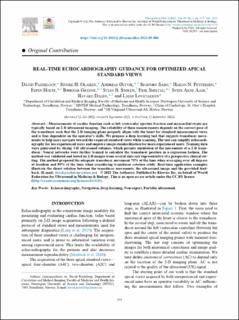| dc.contributor.author | Pasdeloup, David Francis Pierre | |
| dc.contributor.author | Olaisen, Sindre Hellum | |
| dc.contributor.author | Østvik, Andreas | |
| dc.contributor.author | Sæbø, Sigbjørn | |
| dc.contributor.author | Pettersen, Håkon Neergaard | |
| dc.contributor.author | Holte, Espen | |
| dc.contributor.author | Grenne, Bjørnar | |
| dc.contributor.author | Stølen, Stian Bergseng | |
| dc.contributor.author | Smistad, Erik | |
| dc.contributor.author | Aase, Svein Arne | |
| dc.contributor.author | Dalen, Håvard | |
| dc.contributor.author | Løvstakken, Lasse | |
| dc.date.accessioned | 2023-04-21T12:02:31Z | |
| dc.date.available | 2023-04-21T12:02:31Z | |
| dc.date.created | 2022-11-09T17:08:59Z | |
| dc.date.issued | 2022 | |
| dc.identifier.citation | Ultrasound in Medicine and Biology. 2023, 49 (1), 333-346. | en_US |
| dc.identifier.issn | 0301-5629 | |
| dc.identifier.uri | https://hdl.handle.net/11250/3064267 | |
| dc.description.abstract | Measurements of cardiac function such as left ventricular ejection fraction and myocardial strain are typically based on 2-D ultrasound imaging. The reliability of these measurements depends on the correct pose of the transducer such that the 2-D imaging plane properly aligns with the heart for standard measurement views and is thus dependent on the operator's skills. We propose a deep learning tool that suggests transducer movements to help users navigate toward the required standard views while scanning. The tool can simplify echocardiography for less experienced users and improve image standardization for more experienced users. Training data were generated by slicing 3-D ultrasound volumes, which permits simulation of the movements of a 2-D transducer. Neural networks were further trained to calculate the transducer position in a regression fashion. The method was validated and tested on 2-D images from several data sets representative of a prospective clinical setting. The method proposed the adequate transducer movement 75% of the time when averaging over all degrees of freedom and 95% of the time when considering transducer rotation solely. Real-time application examples illustrate the direct relation between the transducer movements, the ultrasound image and the provided feedback. | en_US |
| dc.language.iso | eng | en_US |
| dc.publisher | Elsevier | en_US |
| dc.rights | Navngivelse 4.0 Internasjonal | * |
| dc.rights.uri | http://creativecommons.org/licenses/by/4.0/deed.no | * |
| dc.title | Real-Time Echocardiography Guidance for Optimized Apical Standard Views | en_US |
| dc.title.alternative | Real-Time Echocardiography Guidance for Optimized Apical Standard Views | en_US |
| dc.type | Peer reviewed | en_US |
| dc.type | Journal article | en_US |
| dc.description.version | publishedVersion | en_US |
| dc.rights.holder | © 2022 The Author(s) | en_US |
| dc.source.pagenumber | 333-346 | en_US |
| dc.source.volume | 49 | en_US |
| dc.source.journal | Ultrasound in Medicine and Biology | en_US |
| dc.source.issue | 1 | en_US |
| dc.identifier.doi | 10.1016/j.ultrasmedbio.2022.09.006 | |
| dc.identifier.cristin | 2071428 | |
| dc.relation.project | Norges forskningsråd: 237887 | en_US |
| cristin.ispublished | true | |
| cristin.fulltext | postprint | |
| cristin.qualitycode | 2 | |

